A Fuzzy-Genetic-Based Integration of Renewable Energy Sources and E-Vehicles
Abstract
:1. Introduction
- Increase the penetration and dependency on renewable energy sources;
- Integrate RES to distribution grid at consumer end, reduce active and reactive power losses, and maintain voltage profile;
- E-Vehicles are used as backup source of energy and integrate with the grid at suitable locations with suitable size;
- Integrate RES and e-Vehicles in hybrid mode to maintain the voltage profile and to reduce active and reactive power losses using fuzzy logic approach and genetic algorithms.
1.1. Litterature Review
1.2. Problem Formulation
1.3. Objectives
- ▪
- Integration of RES and EVCS into an IEEE 33-node radial distribution system using Fuzzy Logic and Genetic Algorithm (FL-GA) to keep electrical constraints within permissible limits;
- ▪
- Manage the demand of consumers using RES near load centers to reduce the active and reactive power losses in the distribution network;
- ▪
- Integrate an e-Vehicle charging station using vehicle-to-grid integration to maintain the peak energy consumption.
1.4. Methodology
2. Problem Formulation
- i.
- Backward Sweep
- ii.
- Forward Sweep
- iii.
- Active and Reactive Power losses
3. Objective Function
4. Capacity Optimization Using Fuzzy Logic
5. Location Optimization Genetic Algorithm
6. Simulation Result
6.1. Simulation scenario
6.2. RES Integration
6.3. EVCS Integration
6.4. RES and EVCS Integrate
6.5. Comparative Analysis
- ▪
- A fuzzy logic approach is used for size identification at each node and a genetic algorithm is used for optimal location identification. The first step is to integrate RES to the IEEE 33 node radial distribution network. In the second case, EVCS is integrated into an IEEE 33 node radial distribution network. In the third case, both RES and EVCS are integrated in hybrid mode with IEEE 33 node radial distribution network and the results of all three networks compared.
- ▪
- The voltage profile improved from 0.90 pu without RES and EVCS to 0.94 pu with RES at node 28, 4.44%; 0.911 pu with EVCS at node 9 improved by 1.11% and 0.97 pu with RES and EVCS in hybrid mode improved by 7.77% at nodes 9 and 28.
- ▪
- Active power losses reduced from 217.48 kW without RES and EVCS to 195.35 kW with RES reduced by 10.17%, 160.62 kW with EVCS reduced by 26.14%, and 108.88 kW with RES and EVCS reduced by 49.93%.
- ▪
- Reactive power losses are reduced from 141.34 kVAr without RES and EVCS to 116.095 kVAr with RES reduced by 17.85%, 104.98 kVAr with EVCS reduced by 25.72%, and 103.88 kVAr with RES and EVCS reduced by 23.67% at nodes 9 and 28.
7. Discussion
8. Conclusions
Author Contributions
Funding
Data Availability Statement
Acknowledgments
Conflicts of Interest
References
- Talwariya, A.; Singh, P.; Kolhe, M.L. Stackelberg Game Theory Based Energy Management Systems in the Presence of Renewable Energy Sources. IETE J. Res. 2021, 67, 611–619. [Google Scholar] [CrossRef]
- Xu, Y.; Zheng, Y.; Yang, Y. On the movement simulations of E-Vehicles: A behavioral model-based approach. Appl. Energy 2021, 283, 116356. [Google Scholar] [CrossRef]
- Wang, T.; Luo, H.; Zeng, X.; Yu, Z.; Liu, A.; Sangaiah, A.K. Mobility based trust evaluation for heterogeneous E-Vehicles network in smart cities. IEEE Trans. Intell. Transp. Syst. 2020, 22, 1797–1806. [Google Scholar] [CrossRef]
- Zhang, Y.; Wang, J.; Li, Z. Uncertainty modeling of distributed energy resources: Techniques and challenges. Curr. Sustain. Renew. Energy Rep. 2019, 6, 42–51. [Google Scholar] [CrossRef]
- Burger, S.P.; Luke, M. Business models for distributed energy resources: A review and empirical analysis. Energy Policy 2017, 109, 230–248. [Google Scholar] [CrossRef]
- Mahmud, K.; Khan, B.; Ravishankar, J.; Ahmadi, A.; Siano, P. An internet of energy framework with distributed energy resources, prosumers and small-scale virtual power plants: An overview. Renew. Sustain. Energy Rev. 2020, 127, 109840. [Google Scholar] [CrossRef]
- Paglia, E.; Parker, C. The intergovernmental panel on climate change: Guardian of climate science. In Guardians of Public Value; Palgrave Macmillan: Cham, Switzerland, 2021; pp. 295–321. [Google Scholar]
- He, W.; Tao, L.; Han, L.; Sun, Y.; Campana, P.E.; Yan, J. Optimal analysis of a hybrid renewable power system for a remote island. Renew. Energy 2021, 179, 96–104. [Google Scholar] [CrossRef]
- Boretti, A.; Castelletto, S. Cost and performance of CSP and PV plants of capacity above 100 MW operating in the United States of America. Renew. Energy Focus 2021, 39, 90–98. [Google Scholar] [CrossRef]
- Alves, O.; Calado, L.; Panizio, R.M.; Gonçalves, M.; Monteiro, E.; Brito, P. Techno-economic study for a gasification plant processing residues of sewage sludge and solid recovered fuels. Waste Manag. 2021, 131, 148–162. [Google Scholar] [CrossRef]
- Alsharif, A.; Tan, C.W.; Ayop, R.; Dobi, A.; Lau, K.Y. A comprehensive review of energy management strategy in Vehicle-to-Grid technology integrated with renewable energy sources. Sustain. Energy Technol. Assess. 2021, 47, 101439. [Google Scholar] [CrossRef]
- Ouramdane, O.; Elbouchikhi, E.; Amirat, Y.; Gooya, E.S. Optimal Sizing and Energy Management of Microgrids with Vehicle-to-Grid Technology: A Critical Review and Future Trends. Energies 2021, 14, 4166. [Google Scholar] [CrossRef]
- Huang, B.; Meijssen, A.G.; Annema, J.A.; Lukszo, Z. Are electric vehicle drivers willing to participate in vehicle-to-grid contracts? A context-dependent stated choice experiment. Energy Policy 2021, 156, 112410. [Google Scholar] [CrossRef]
- Bibak, B.; Tekiner-Moğulkoç, H. A comprehensive analysis of Vehicle to Grid (V2G) systems and scholarly literature on the application of such systems. Renew. Energy Focus 2021, 36, 1–20. [Google Scholar] [CrossRef]
- Rolán, A.; Bogarra, S.; Bakkar, M. Integration of Distributed Energy Resources to Unbalanced Grids under Voltage Sags with Grid Code Compliance. IEEE Trans. Smart Grid 2021, 13, 355–366. [Google Scholar] [CrossRef]
- Gill, A.; Singh, P. Optimal penetration of distributed generation system in radial distribution network using adaptive scheme. J. Phys. Conf. Ser. 2021, 1914, 012027. [Google Scholar] [CrossRef]
- Hadingham, W.; Rayney, K.; Blaver, A.; Smart, B.; Thomas, J. Distributed Energy Resources Roadmap: How the State of Western Australia Is Leading in Integration. In IEEE Power and Energy Magazine; 20 August 2021; Volume 19, pp. 76–88. [Google Scholar]
- Talwariya, A.; Singh, P.; Kolhe, M. A stepwise power tariff model with game theory based on Monte-Carlo simulation and its applications for household, agricultural, commercial and industrial consumers. Int. J. Electr. Power Energy Syst. 2019, 111, 14–24. [Google Scholar] [CrossRef]
- Rao, S.S. Engineering Optimization: Theory and Practice, 3rd ed.; Wiley-Inter Science: New York, NY, USA, 1996. [Google Scholar]
- Lalitha, M.P. Application of Fuzzy and ABC Algorithm for DER Placement for Minimum Loss in Radial Distribution System. Iran. J. Electr. Electron. Eng. 2010, 6, 248–257. [Google Scholar]
- Kumawat, A.; Choudhary, R.; Singh, P. Optimal Placement of DER and Capacitor for Minimizing the Power Losses using Genetic Algorithm. Int. Res. J. Eng. Technol. 2015, 2, 2306–2309. [Google Scholar]
- Della Marca, R.; d’Onofrio, A. Volatile opinions and optimal control of vaccine awareness campaigns: Chaotic behaviour of the forward-backward sweep algorithm vs. heuristic direct optimization. Commun. Nonlinear Sci. Numer. Simul. 2021, 98, 105768. [Google Scholar] [CrossRef]
- Hota, A.P.; Mishra, S. A forward-backward sweep based numerical approach for active power loss allocation of radial distribution network with distributed generations. Int. J. Numer. Model. Electron. Netw. Devices Fields 2021, 34, e2788. [Google Scholar]
- Abu-Mouti, F.S.; El-Hawary, M.E. Optimal Distributed Generation Allocation and Sizing in Distribution Systems via Artificial Bee Colony Algorithm. IEEE Trans. Power Deliv. 2011, 26, 2090–2101. [Google Scholar] [CrossRef]
- Gill, A.; Choudhary, A.; Bali, H. Renewable Distributed Generations Optimal Penetration in the Distribution Network for Clean and Green Energy. Asian J. Water Environ. Pollut. 2021, 18, 37–43. [Google Scholar] [CrossRef]
- Naik, S.N.G.; Khatod, D.K.; Sharma, M.P. Analytical approach for optimal siting and sizing of distributed generation in radial distribution networks. IET Gener. Transm. Distrib. 2015, 9, 209–220. [Google Scholar] [CrossRef]
- Rialland, R.; Carrère, V.; Marion, R.; Soussen, C. Identification of minerals from hyperspectral imaging based on a fuzzy logic approach. In Proceedings of the Algorithms, Technologies, and Applications for Multispectral and Hyperspectral Imaging XXVII, online, 12–16 April 2021; International Society for Optics and Photonics: Bellingham, WA, USA, 2021; Volume 11727. [Google Scholar]
- Thakare, V.R. Computational trust evaluation algorithm for cloud models using fuzzy logic approach. Int. J. Ad Hoc Ubiquitous Comput. 2021, 38, 127–140. [Google Scholar] [CrossRef]
- Talwariya, A.; Singh, P. Optimization of distribution networks with integration of distributed generators using cooperative Game Theory. Int. J. Power Energy Syst. 2019, 39, 1–7. [Google Scholar] [CrossRef]
- Wan, S.; Liang, X.; Jiang, H.; Sun, J.; Djilali, N.; Zhao, T. A coupled machine learning and genetic algorithm approach to the design of porous electrodes for redox flow batteries. Appl. Energy 2021, 298, 117177. [Google Scholar] [CrossRef]
- Park, J.S.; Ng, H.Y.; Chua, T.J.; Ng, Y.T.; Kim, J.W. Unified genetic algorithm approach for solving flexible job-shop scheduling problem. Appl. Sci. 2011, 11, 6454. [Google Scholar] [CrossRef]
- Talwariya, A.; Singh, P.; Kolhe, M.L.; Jobanputra, J.H. Fuzzy logic controller and game theory based distributed energy resources allocation. AIMS Energy 2020, 8, 474–492. [Google Scholar] [CrossRef]
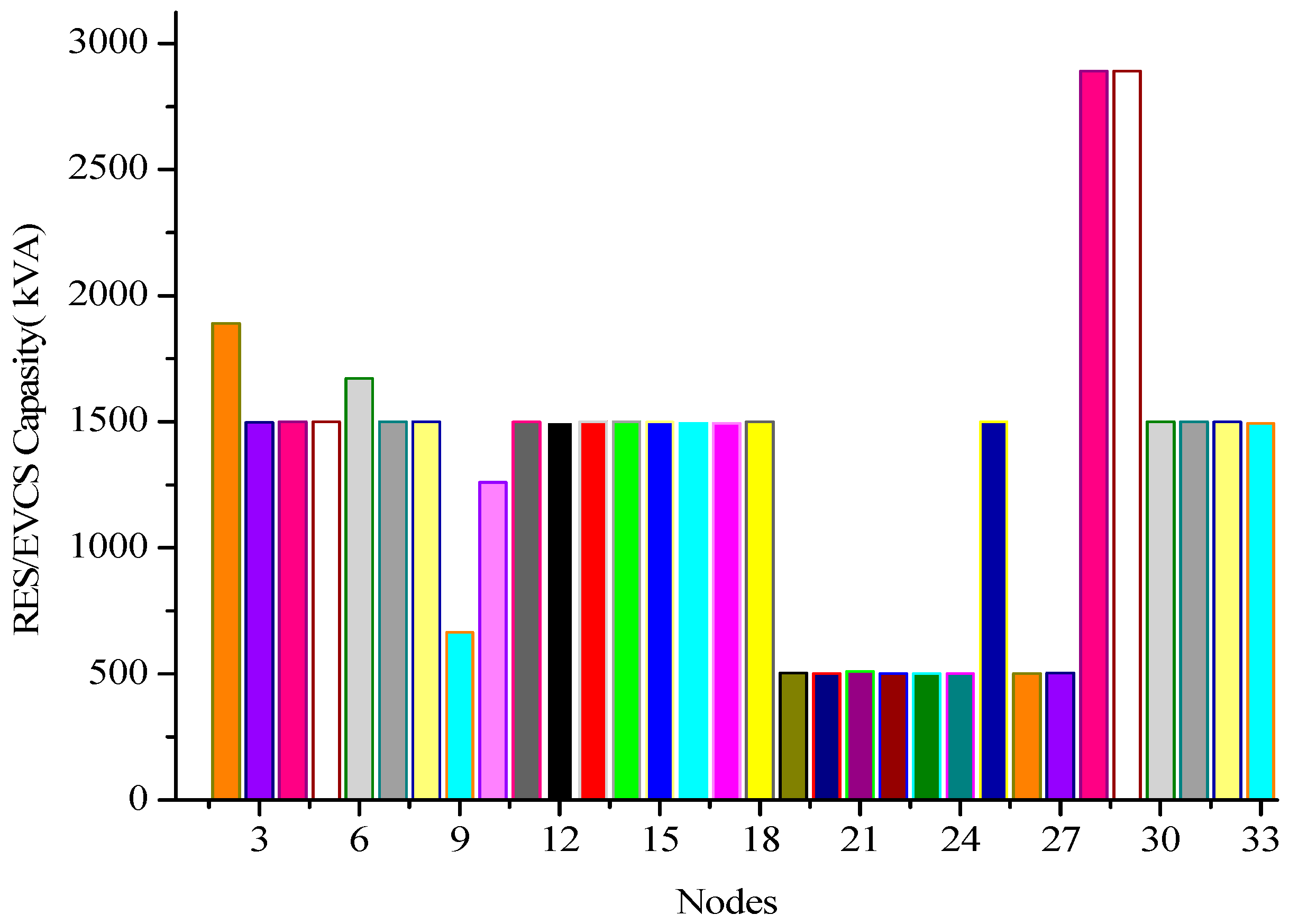

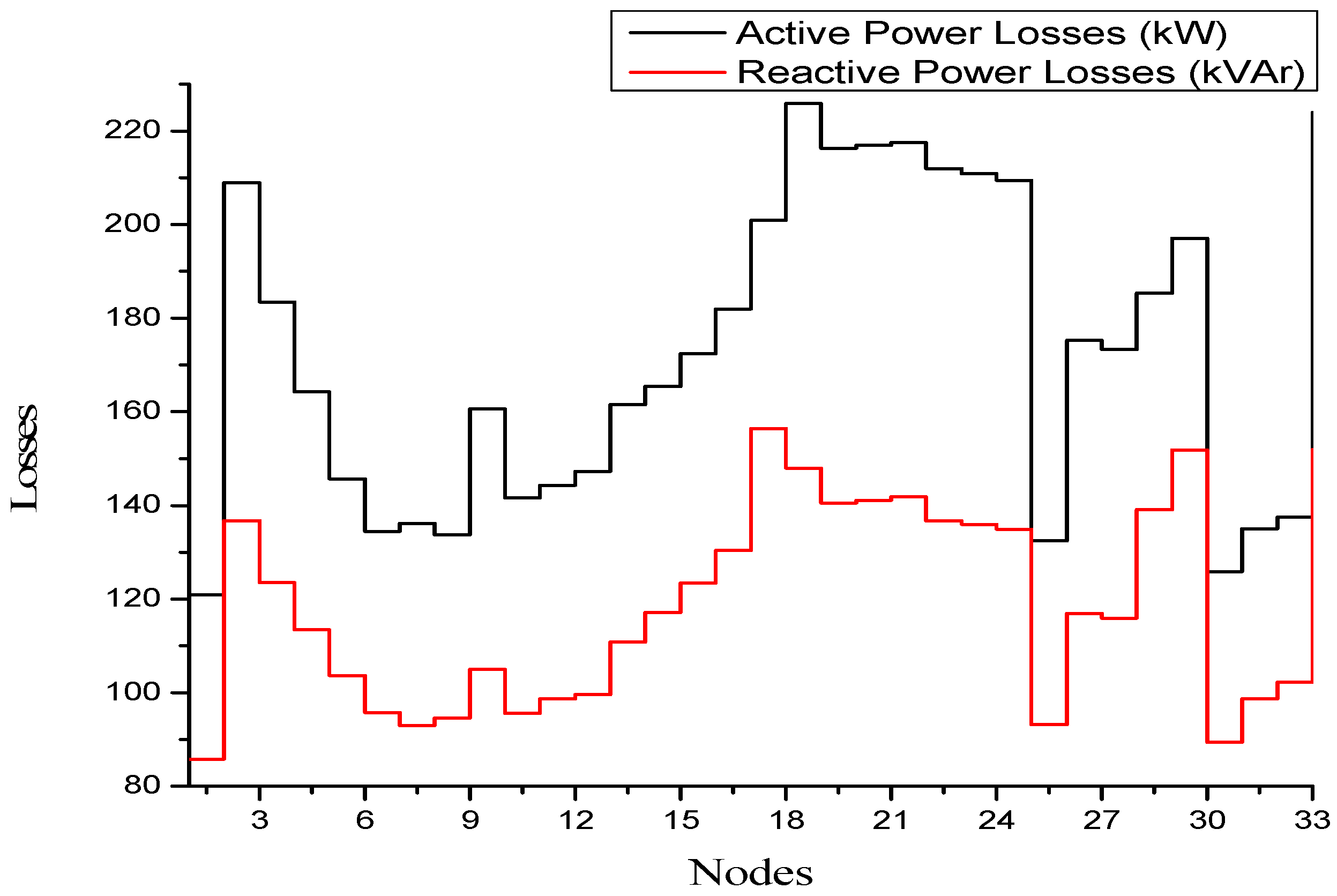

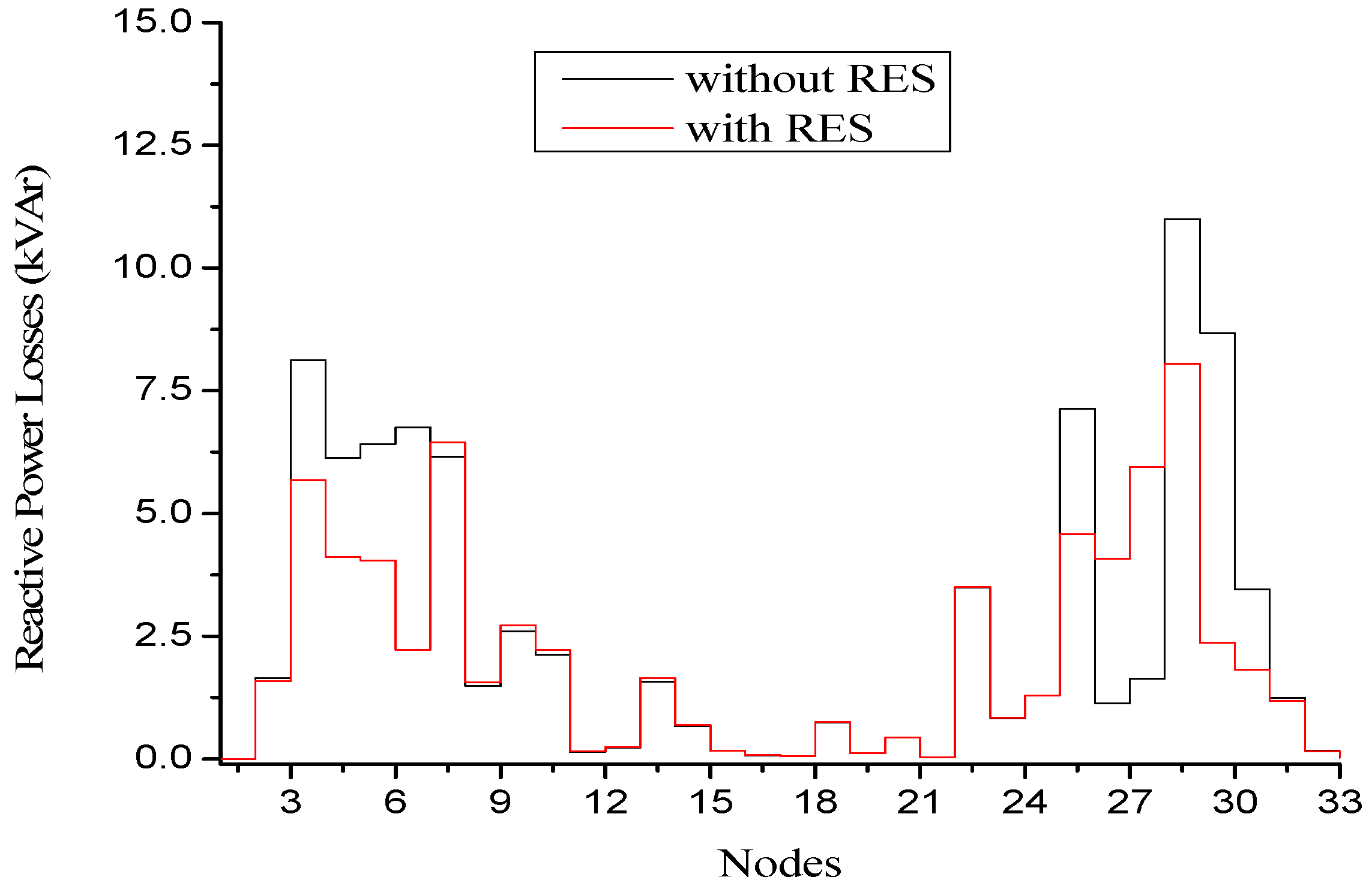
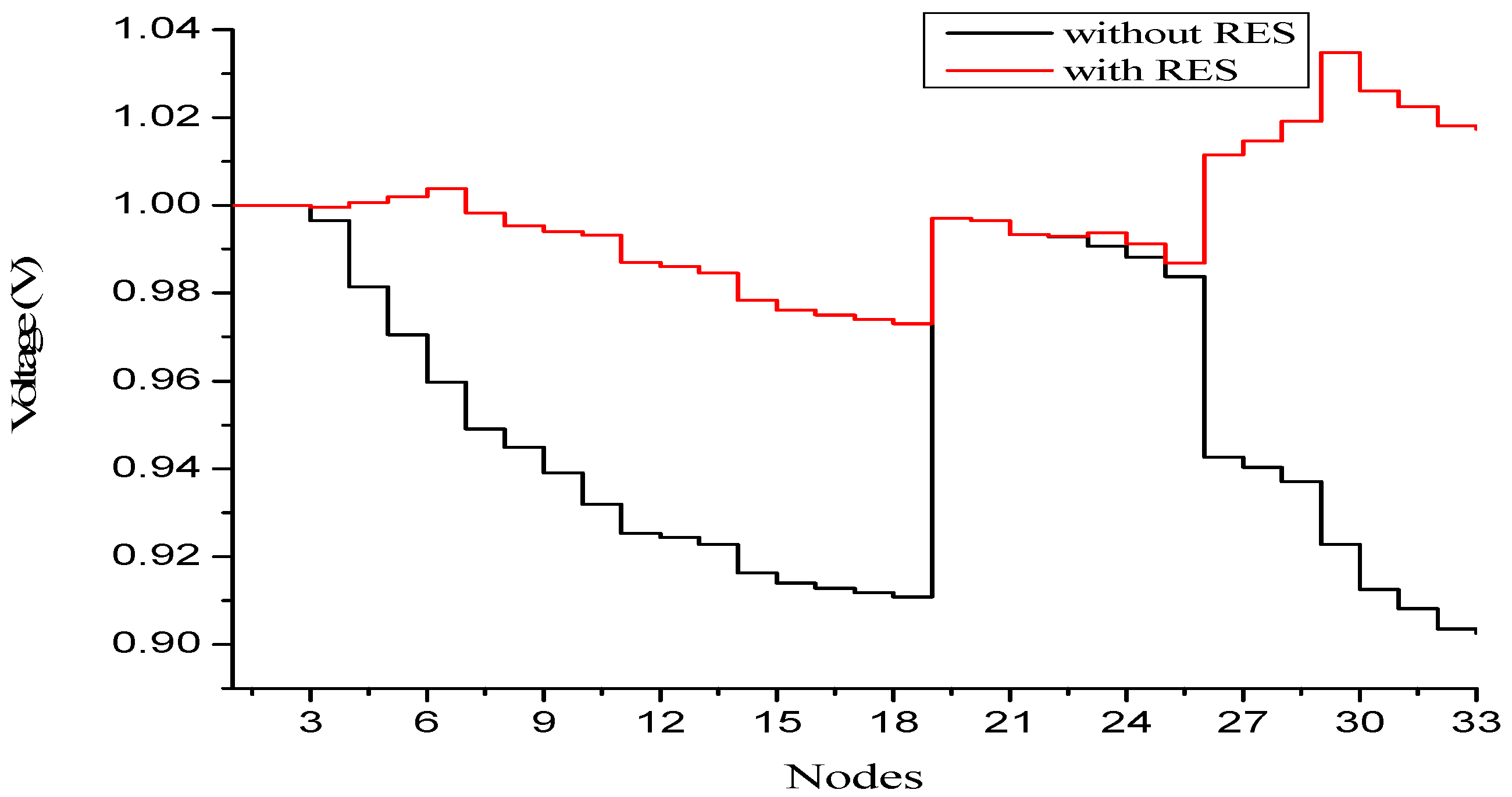
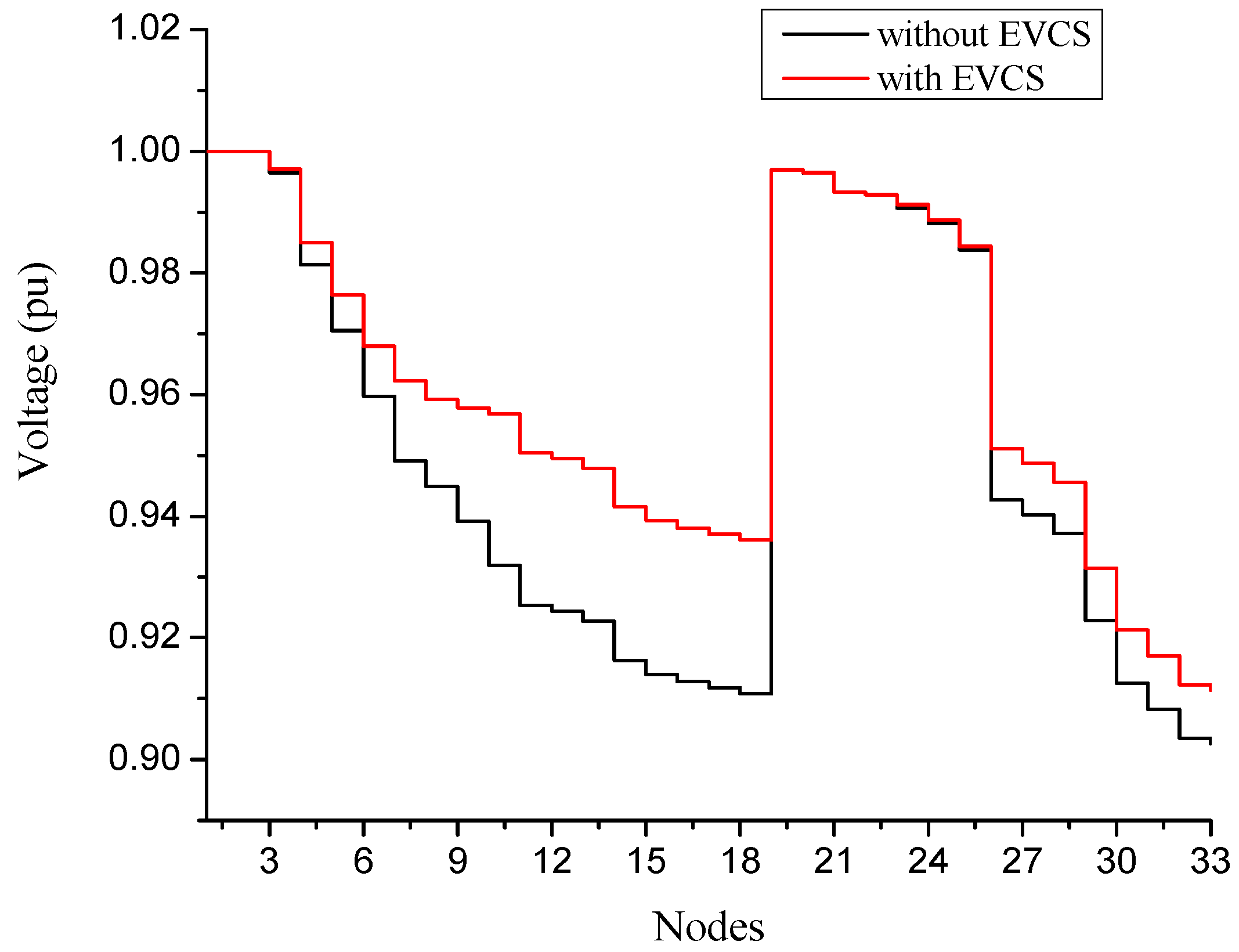
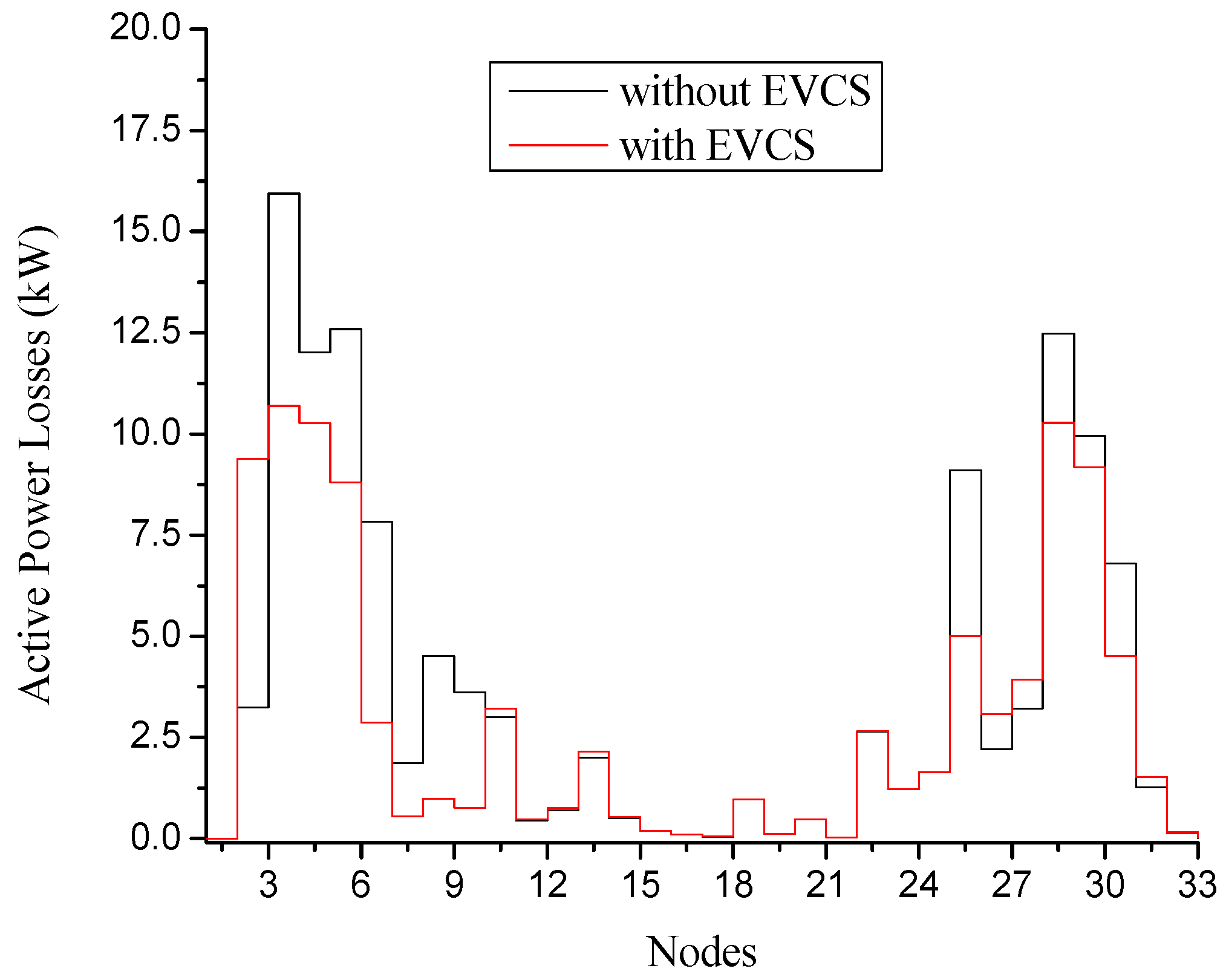

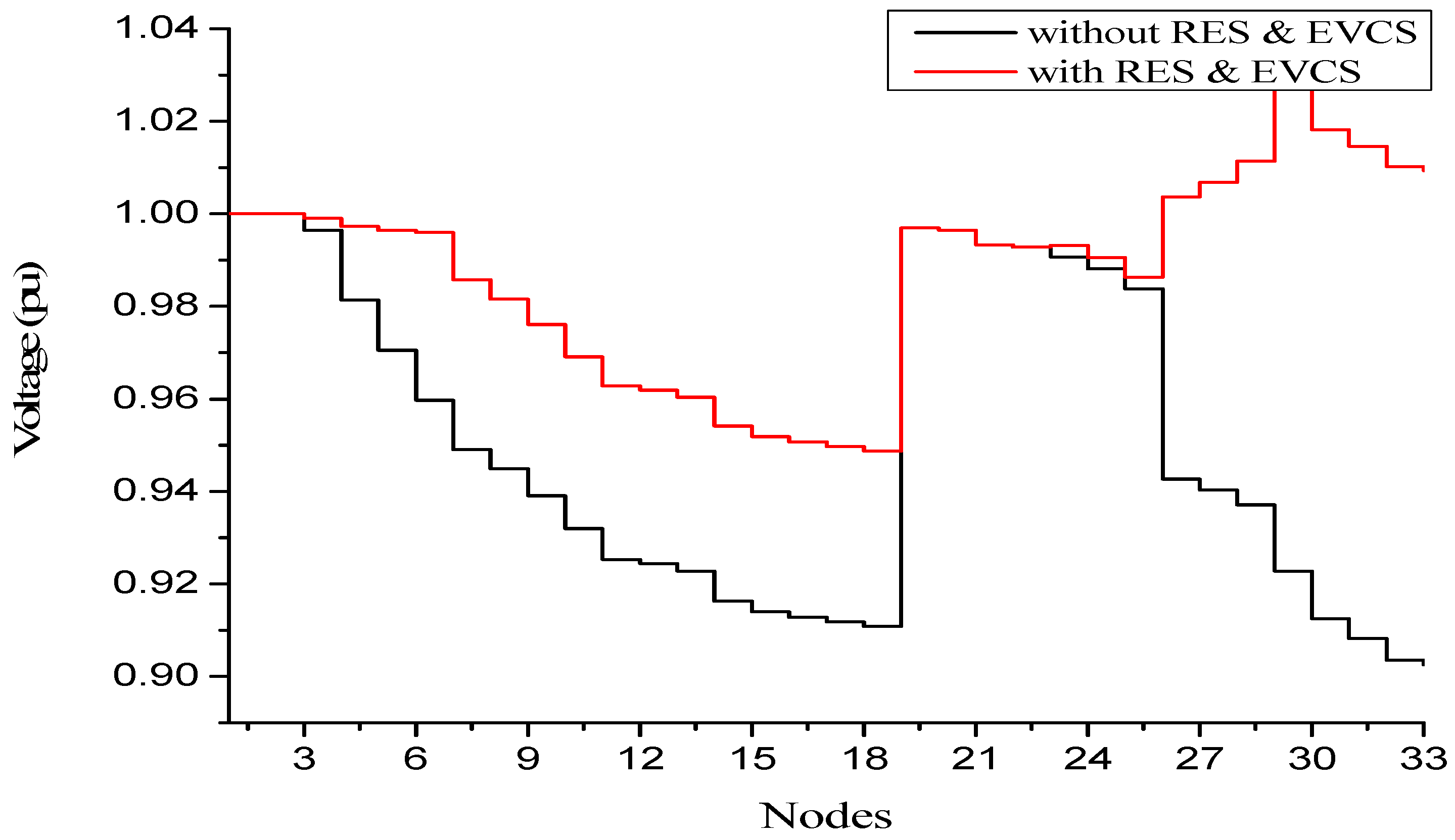


| Parameters | Without RES | With RES |
|---|---|---|
| RES Capacity | - | 2891.56 kVA |
| Integration Location (node) | - | 28 |
| Total Active Power Losses | 216.84 kW | 185.35 kW |
| Total Reactive Power Losses | 141.34 kVAr | 139.10 kVAr |
| Min. Node Voltage | 0.90 pu | 0.94 pu |
| Parameters | Without EVCS | With EVCS |
|---|---|---|
| EVCS Capacity | - | 663.9 kVA |
| Integration Location (node) | - | 9 |
| Total Active Power Losses | 216.84 kW | 160.62 kW |
| Total Reactive Power Losses | 141.34 kVAr | 104.98 kVAr |
| Min. Node Voltage | 0.90 pu | 0.91 pu |
| Parameters | Without RES and EVCS | With RES and EVCS |
|---|---|---|
| RES and EVCS Capacity | - | 3555.46 kVA |
| Integration Location (node) | - | 28 and 9 |
| Total Active Power Losses | 216.84 kW | 108.88 kW |
| Total Reactive Power Losses | 141.34 kVAr | 103.88kVAr |
| Min. Node Voltage | 0.90 pu | 0.97 pu |
| Parameters | Without RES and EVCS | With RES | With RES (%) | With EVCS | With EVCS (%) | With RES and EVCS | With RES and EVCS (%) |
|---|---|---|---|---|---|---|---|
| Integration Location (node) | *** | 28 | *** | 9 | *** | 28 and 9 | *** |
| Integration Capacity (kVA) | *** | 2891.56 | *** | 663.9 | *** | 3555.46 | *** |
| Min. Node Voltage (pu) | 0.90 | 0.94 | 4.44 | 0.91 | 1.11 | 0.97 | 7.77 |
| Total Active Power Losses (kW) | 217.48 | 195.35 | 10.17 | 160.62 | 26.14 | 108.88 | 49.93 |
| Total Reactive Power Losses (kVAr) | 141.34 | 116.10 | 17.85 | 104.98 | 25.72 | 107.88 | 23.67 |
| Without RES | With RES | ||||
|---|---|---|---|---|---|
| MN Method | PLS Method | VSA Method | FLA-GT Method | ||
| Integration Location (node) | *** | 6 | 28 | 17 | 6 and 30 |
| Integration Capacity (kVA) | *** | 2093.5 | 1600 | 800 | 3171.45 |
| Min. Node Voltage (pu) | 0.90 | 0.91 | 0.93 | 0.91 | 0.96 |
| Total Active Power Losses (kW) | 217.48 | 133.09 | 125.39 | 162.11 | 107.84 |
| Total Reactive Power Losses (kVAr) | 141.34 | 109.39 | 89.73 | 111.78 | 77.33 |
Publisher’s Note: MDPI stays neutral with regard to jurisdictional claims in published maps and institutional affiliations. |
© 2022 by the authors. Licensee MDPI, Basel, Switzerland. This article is an open access article distributed under the terms and conditions of the Creative Commons Attribution (CC BY) license (https://creativecommons.org/licenses/by/4.0/).
Share and Cite
Agrawal, H.; Talwariya, A.; Gill, A.; Singh, A.; Alyami, H.; Alosaimi, W.; Ortega-Mansilla, A. A Fuzzy-Genetic-Based Integration of Renewable Energy Sources and E-Vehicles. Energies 2022, 15, 3300. https://doi.org/10.3390/en15093300
Agrawal H, Talwariya A, Gill A, Singh A, Alyami H, Alosaimi W, Ortega-Mansilla A. A Fuzzy-Genetic-Based Integration of Renewable Energy Sources and E-Vehicles. Energies. 2022; 15(9):3300. https://doi.org/10.3390/en15093300
Chicago/Turabian StyleAgrawal, Himanshi, Akash Talwariya, Amandeep Gill, Aman Singh, Hashem Alyami, Wael Alosaimi, and Arturo Ortega-Mansilla. 2022. "A Fuzzy-Genetic-Based Integration of Renewable Energy Sources and E-Vehicles" Energies 15, no. 9: 3300. https://doi.org/10.3390/en15093300







